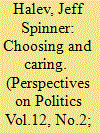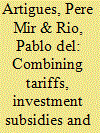| Srl | Item |
| 1 |
ID:
132980


|
|
|
|
|
| Publication |
2014.
|
| Summary/Abstract |
Choice and markets have always been central to liberalism. Liberals wants people to choose their occupation, their partners, and what goods to buy. All liberals agree that making choices is central to the autonomous life. But the scope and conditions of choice quickly becomes controversial among liberals, as the four books under review reveal. Joan Tronto and Michael Sandel worry about the spread of market thinking to all other spheres of life, John Tomasi argues that too many contemporary liberals underestimate the importance of economic liberty, while Sarah Conly argues that we have a large swath of empirical evidence to question the idea that individuals can readily make correct rational decisions. Conly is not against individual autonomy, but she urges us to recognize autonomy's limitations. While political theorists are often reluctant to think about policy, doing so is certainly a virtue when the topic is markets and choice; one of the strengths of Conly's and Tronto's books is their willingness to apply their arguments to specific policy realms.
|
|
|
|
|
|
|
|
|
|
|
|
|
|
|
|
| 2 |
ID:
132678


|
|
|
|
|
| Publication |
2014.
|
| Summary/Abstract |
Policy combinations and interactions have received a considerable attention in the climate and energy policy realm. However, virtually no attention has been paid to the analysis of the combination of different deployment instruments for the same renewable energy technology. This neglect is all the more striking given the existence in current policy practice of combinations of deployment instruments either across technologies or for the same technology, both in the EU and elsewhere. What renewable electricity support policies to use and, therefore, how to combine them in order to promote the deployment of renewable energy technologies cost-effectively is a main concern of governments. The aim of this paper is to provide insight on the cost-effectiveness of combinations of deployment instruments for the same technology. A financial model is developed for this purpose, whereby feed-in tariffs (FITs) are combined with investment subsidies and soft loans. The results show that the policy costs of combinations are the same as for the FITs-only option. Therefore, combining deployment instruments is not a cost-containment strategy. However, combinations may lead to different inter-temporal distributions of the same amount of policy costs and, thus, differently affect the social acceptability and political feasibility of renewable energy support.
|
|
|
|
|
|
|
|
|
|
|
|
|
|
|
|